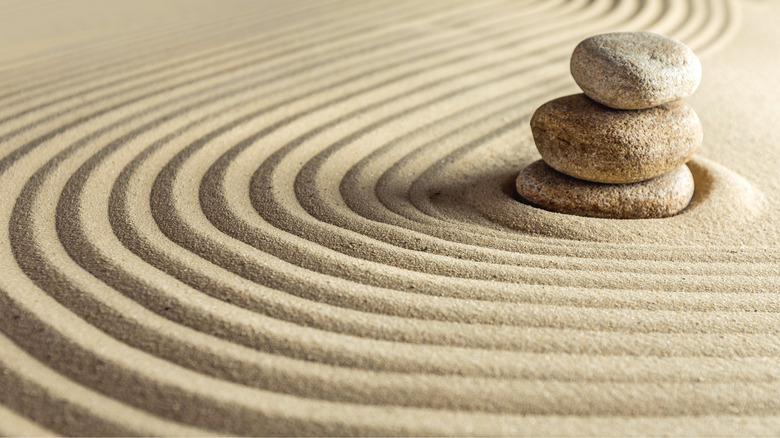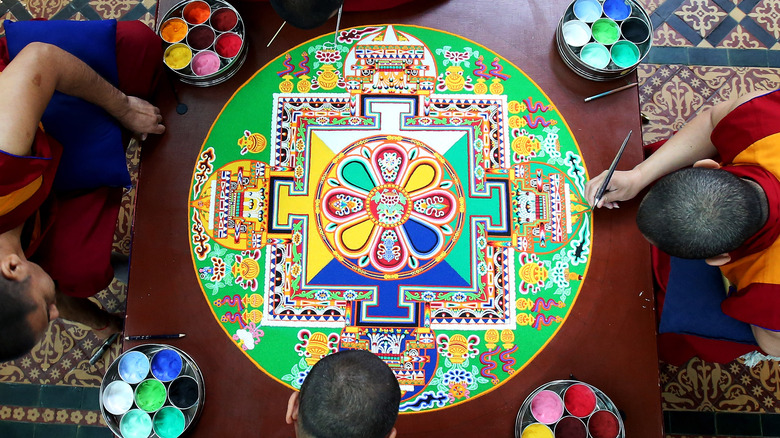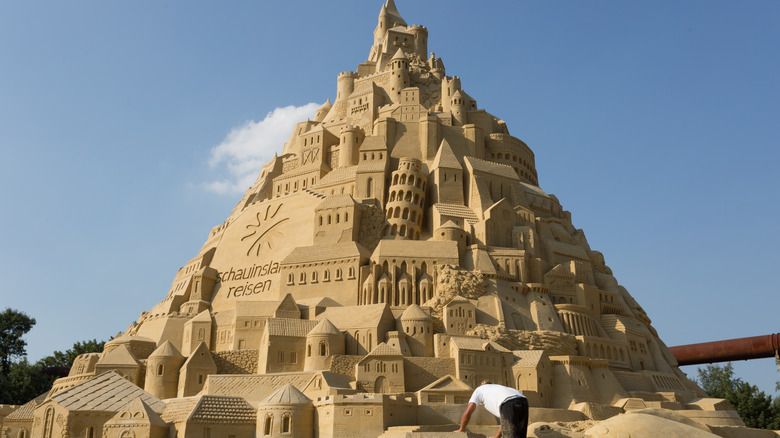The Craft Of Sand Art Is Older Than You Think
Lots of folks might have fond memories of trundling to the beach as a kid with a plastic shovel and pail, and digging down into the sand to attempt to build a sand castle. Maybe the sand was dry and hot, and kept sliding away. Or maybe it was wet and clumpy because high tide was rolling in bit by bit and obliterating your best attempts at construction. One thing's for sure: It was all way, way harder than it looked.
Enter sand art: a realm of highly skilled, highly controlled artistry that would leave most of us with our jaws dropped and wondering: How in the heck did they do that? We're talking way beyond upended red plastic buckets on the beach. Shirara-hama Beach at the southern tip of Izu Peninsula in Japan, south of Tokyo, has a 47-year-long sand art contest that produces some truly stunning works of 3D contemporary (and temporary) art, as Japan Travel shows. Across the ocean, the International Sand Art competition in Key West showcases some experimental, creative work that reveals an amazing level of craftsmanship, per Just Sand and Water. The Pitt Program Council at the University of Pittsburgh holds contests, as does Point Reyes National Seashore in California. These are just a few examples of a whole array of worldwide contests and classes at the amateur, professional, and kid-focused levels.
Well before the present, though, people were playing with, and sculpting, Earth's free, shoreline-and-desert art material.
Tibetan sand mandalas go back thousands of years
Even though we're 100% sure that humans have always had fun shaping sand on the beach, the oldest form of recorded sand art is far more serious, and far older, than you might realize. It goes back to mandalas, sacred Buddhist artwork composed of a combination of geometric shapes and detailed images. Mandalas, effectively, tell stories meant to confer truths about existence. The use of sand to make mandalas is intentional, as it reflects the impermanence of life and human effort.
Pictures of mandalas first showed up in the Vedas, ancient Hindu texts dating back to 1500-1000 BCE, which means that they existed far before their images were put to print — there's no way to preserve sand art, after all. When Siddhartha Gautama (563-483 BCE) became the first Buddha and broke from away from Hinduism to essentially "found" Buddhism, as World History explains, the tradition of mandalas went with him. And now, Tibetan monks painstakingly use one single grain of colored sand at a time to craft gorgeous and intricate work. And then, after a little ceremony, as you can watch on ABC10 (posted on YouTube), they destroy their creations.
More recently, per The Hindu, the Indian poet Balaram Das in the 15th century is credited with crafting 3D sand chariots on the beach because his caste wasn't allowed to visit the temple of the chariot-riding god Jagganath.
World record-breaking sand castles
Fast forward quite a bit and we've got the first recorded instance of totally-not-Buddhist, 3D fine sand art (like the giant castle above). In 1897, Philip McCord sculpted a realistic likeness of a drowned woman and her baby that caught the attention of locals and spread to an actual, beach-based business in Atlantic City, New Jersey. Folks visited and paid to watch artists craft sand art on the beach. Around the same time in 1901, as Sand City Egypt continues, an article appeared in The Strand Magazine about Eugen Bormel, a professor who created 3D sand sculptures on the German coast at the town of Nordeney. Bormel preferred either desert- or aquatic-themed subjects, like the Sphinx or mermaids, much like current-day sand artists. As the article said, bigger sculptures drew people's attention even back then.
In accordance with that bigger-and-better trend, the current world-record holder for tall sand castles was finished on July 2, 2021, in Blokhus, Denmark. As Guinness World Records shows, the 21-meter-tall (almost 70 feet) castle was built to boost tourism coming out of the COVID-19 pandemic, and intended to last about six months. A previous world record holder at Binz, Germany, was finished June 5, 2019 after two years of attempts, and measured about 17.5 meters (almost 58 feet), again per Guinness World Records. These kinds of creations are the work of whole teams of designers, sculptors, and architects who don't use any internal structures or water to hold the sand together.
Live sand art stories told by masters
Along with Buddhist mandalas, giant sand castles, and art deco installations, there's minimalist, Japanese "dry landscape" rock gardens, which rake sand into graceful, contoured shapes around rocks. As My Modern Met says, such traditions have existed since the Muromachi period in the 14th to 15th centuries, parallel to the European Renaissance. Such art has become expressions of Japanese Buddhism, "Zen," and focus on the contrast between structures and negative space, typically to embody concepts of emptiness and nature. To give you an idea how long such sensibilities have been around, Japan has the honor of having the world's first published gardening manual in the 11th century, called "Sakuteiki."
On the ultra-modern side, sand art has also gone back to 2D — specifically, live sand art shows that use light to project negative space (just like a Japanese rock garden) onto a screen in a dark room. Artists sprinkle sand on a flat panel, which is projected onto screens behind them, and use the sand to tell stories before wiping each panel clean, again and again. Recordings of artists like Afu on YouTube show exactly how virtuosic these performances can be. As D'Source says, this version of sand art has been around for about a decade.
Besides these, some artists have created sand art meant to last, on canvases like paintings, such as those on Art History Project. Such art took off in the 1970s, but some pieces go back to the early 20th century.



